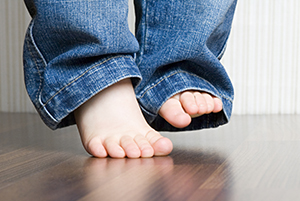What to do about toe walking
Pediatric Physical Therapist
CentraCare Health – Long Prairie
Your child needs to be able to walk before he or she can run. But what should you do if they aren’t walking the right way?
After age 2, most children learn to walk using their full foot — from heel to toe. But some children, for many possible reasons, continue to use only their toes. This condition is called idiopathic toe walking and occurs in 5 to 12 percent of kids.
Several of things to be aware of:
- Children walk on their toes for many reasons. It might have to do with foot alignment, sensory issues, vision or muscle weakness.
- Children with autism-related conditions have been found to toe walk more regularly butthere’s no direct link between the two conditions.
- Some theories as to why children toe walk include that do it out of habit or that they have tight calf muscles or because of some underlying issue that increases muscle tone that make extending one’s heels and walking normally difficult.
- Nonsurgical treatments are available for children between ages 2 and 5 who are not able to walk using a heel-toe pattern. These include exercises, casting or bracing — all in the attempt to stretch and lengthen calf muscles and strengthen the functions of the ankle.
- Persistent toe walking affects foot function needed in skills such as walking at a faster or slower pace, jumping or stopping with control. It can lead to excessive falling.
Among the home program exercises a physical therapist may focus on include:
- Verbal cueing – Give the child reminders to walk coming down on their heels first.
- Jumping and stopping – Practice jumping forward once and stopping.
- Crab walk – This needs to be done keeping the buttocks off the floor and with heels flat.
- Dinosaur steps – Taking extra-long steps which encourage the heel hitting the ground first.
The functional goals of these physical therapy sessions are for the child to:
- Be able to walk and run at typical speeds using proper heel-toe patterns.
- Be able to walk up and down the stairs using only one foot on each step.
- Be able to jump down from heights using both feet together on take-off and landing.
- Be able to stop with control rather than falling.
- Be able to stand on one foot with control.
If you have concerns about your child’s walking or development, contact your child’s provider. If you need assistance in finding a provider for your child, contact CentraCare Connect to help find one and to schedule an appointment.
